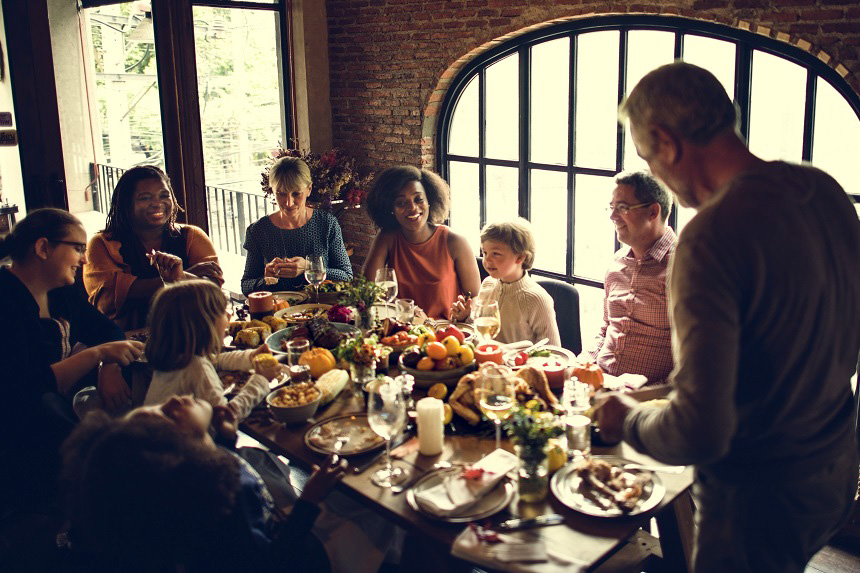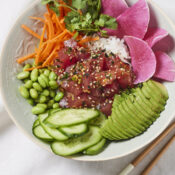Anyone celebrating Thanksgiving with a group of people who all adhere to the exact same diet has much to be thankful for indeed. Can you imagine? For the rest of us, it’s a yearly tradition of juggling preferences, dietary decisions, and strict allergies. However, accommodating for dietary restrictions on Thanksgiving doesn’t have to be so taxing that you forget it’s a four-day weekend. With some planning, you can make all of your guests feel comfortable without adding the work of a four-star chef to your holiday.
There are a few things to remember when you have guests who require some tweaks to the feast menu:
- Ask about your guests’ needs ahead of time. The sooner you know what people can and can’t eat, the more time you have to prepare an accommodating meal.
- They don’t need to eat every single dish on the table. People with specific diets are used to opting out of certain foods. Remember that, between every dish available, much of your spread will probably meet their needs. They will likely be ecstatic if you make anything special at all.
- Everything doesn’t have to be made from scratch. We are living in the golden age of specialty grocery stores where you can find a cornucopia of packaged products to suit almost every need. They will also have dietary restrictions marked clearly, to eliminate any confusion.
- Use index cards to mark special dishes on the buffet. Just because your nephew’s fiance is vegan, that doesn’t mean she wants a big discussion about it. She’ll be thankful for your discretion.
- Ask your guests to bring a dish to the party. If you’re feeling overwhelmed with dietary caveats, there’s nothing wrong with asking people to “pitch in” a side that suits their needs. If you do, ask this of all your guests so it doesn’t seem as though you’re put out and can’t be bothered to accommodate your friends with dietary restrictions.
Think of guests with dietary needs as an opportunity to learn new skills in the kitchen and improve your resume as a gracious host. Here are some of the most common diets, along with some dishes you can prepare to wow your meatless and wheatless company.
Gluten-Free
People following a gluten-free diet steer clear of grains like wheat, barley, and rye. In cases of celiac disease, this diet is necessary, but some follow it for health benefits. Gluten is fairly easy to avoid in homemade food (if you aren’t using flour or the aforementioned grains), but it can be tricky to be sure about processed foods if they don’t display a gluten-free (GF) label. The recipe below for Cornbread and Wild Rice Stuffing is a sure thing for non-gluten guests.
This rice flour gravy from The Kitchn is also an easy alternative, as is this Green Bean Casserole from Gluten-Free on a Shoestring.
Vegetarian
Vegetarians don’t eat meat or fish, and that means no meat-based stocks either. Side dishes are easy to make vegetarian by just omitting meat or fish, and you can serve a protein-rich, animal-free main course that even the turkey-eaters will love. Make some simple Red Lentil Meatballs from the recipe below, and check out our guide to making your own meat alternatives.
Vegan
Whereas vegetarians eschew meat, a vegan diet avoids all animal products. Vegan foods will contain no meat, fish, dairy, eggs, or honey. Gelatin is also off-limits. Some side dishes, like mashed potatoes and stuffing, are easy to make vegan. Our recipe for Miso Gravy is a flavorful alternative that assures your vegan guest can still celebrate like the rest of us.
Field Roast’s Celebration Roast is easy to find in stores, and this Quinoa and Kale-Stuffed Acorn Squash from Veganosity is another winner.
Lactose Intolerance
The sugar found in dairy products, lactose, can’t be digested easily by some people. Conveniently, vegan and paleo foods are safe for the lactose intolerant. The recipe below for Baked Butternut Squash Mac and Cheeze is a dairy-free delight.
Brooklyn Farm Girl’s Dairy-Free Mashed Potatoes are a simple alternative you can make alongside your regular mashed potatoes by adding another step.
Paleo
The paleo diet, or caveman diet, limits adherents to foods eaten during the Paleolithic era — lean meats, fruits, vegetables, nuts, seeds, and fish — no grains, beans, potatoes or dairy. The hunter-gatherers at your Thanksgiving table might be okay with leniency on this diet during the holidays, but, if not, you can still provide some caveman-style sides to go with the turkey. Check out the easy recipe for Mashed Cauliflower below.
We also like this Roasted Brussels and Bacon from Nom Nom Paleo and this Chocolate Chip Coconut Banana Bread from Ambitious Kitchen.
Cornbread and Wild Rice Stuffing (Gluten-Free)
- 1 pan gluten-free cornbread, cut and dried like croutons
- 1 cup black rice
- ¼ cup unsalted butter
- 2 celery ribs, minced
- 1 large yellow onion, diced
- 2 ½ cups chicken broth
- 1 tbsp chopped sage leaves
- ¼ cup chopped parsley leaves
- 2 eggs
- Salt and pepper
Instructions:
Melt butter in a pan. Add onion and celery, and cook until fragrant. Add chopped sage and cook for another 2 minutes. Set aside to cool.
Cook rice according to package instructions. It’s okay if the rice is a little undercooked, since it will be cooked more anyway.
In a mixing bowl, combine the cornbread croutons, cooked rice, contents of the pan, parsley, and chicken broth. Stir. Whisk the eggs and add to the bowl.
Transfer the mixing bowl into a buttered baking dish. Cover and bake at 350° F for 45 minutes. Uncover and bake until the top is browned, about 45 minutes more.
Red Lentil Meatballs (Vegetarian)
- 1 cup dried red lentils
- 2 medium sweet potatoes
- ½ cup dried couscous
- 2 garlic cloves, minced
- 1 medium onion, diced
- 1 tsp olive oil
- 2 tsp dried oregano
- 2 tsp dried basil
- 1 tsp vegetarian bouillon
- Salt and pepper (to taste)
- Crushed red pepper flakes (to taste)
- 1 tsp smoked paprika (optional)
Instructions:
Cook the lentils. Bring the water to a boil, then lower it to a simmer until the lentils are done.
Dice the sweet potatoes and boil them until they slide off the tines of a fork.
Cook the couscous according to instructions.
Sauté the onion and garlic lightly in olive oil.
Add all ingredients into a mixing bowl and stir thoroughly. Alternatively, you can blend everything together in a food processor for a smoother texture. Pulse the food processor several times, making sure you don’t overmix.
Form the mixture into 1-inch diameter balls, and space them out on an oiled baking sheet. Cook at 400° F for 10 to 15 minutes, then flip the meatballs and lower the oven temperature to 350° F. Cook for another 20 to 30 minutes.
Serve them in a marinara sauce with parmesan and fresh basil, or make meatball subs.
Miso Gravy (Vegan)
- 3 tbsp vegan butter
- ¼ cup flour
- 1 tbsp white miso paste
- 3 cups vegetable broth (or mushroom broth)
- 1 dash soy sauce
- ¼ tsp onion powder
- Fresh ground black pepper
Instructions:
Melt vegan butter in a pan. Add the flour and stir to create a thick paste.
At the same time, add the miso paste to the broth and heat. Stir to combine.
Add the broth-miso mixture, soy sauce, and onion powder to the pan. Stir vigorously. Add fresh ground pepper and cook to desired thickness. Remember the gravy will thicken more as it cools.
Baked Butternut Squash Mac and Cheeze (Lactose Free, Vegetarian)
- 1 medium butternut squash, halved, with seeds and guts removed
- 2 tsp olive oil
- Salt and pepper
- 1 can coconut milk
- ½ cup nutritional yeast
- 1 tbsp Dijon mustard
- ½ tsp garlic powder
- ½ tsp onion powder
- 1 16-oz. box dried macaroni noodles
- ½ cup panko breadcrumbs, or homemade breadcrumbs
- ½ tsp smoked paprika
Instructions:
Lightly coat the inside of each squash half with olive oil and salt and pepper, then place them face down on a baking sheet and bake at 400° F for 20 minutes.
Once the squash has cooled, scoop the insides of each half into a food processor or blender. Add in the coconut milk, nutritional yeast, Dijon, garlic powder, and onion powder, and process until smooth.
Cook the macaroni noodles according to box instructions. Drain the noodles and combine with the sauce in a baking dish. Top with smoked paprika and panko breadcrumbs and bake at 350° F for 30 minutes.
Mashed Cauliflower (Paleo, Vegan)
1 large head cauliflower, cut into florets
¼ cup almond or coconut milk
2 tbsp olive oil
3 cloves garlic, minced
2 tbsp fresh chives, chopped
Instructions:
Boil 1 ½ inches of water in a pot. Place a steamer basket into the pot and fill with cauliflower florets. Cover and steam for about 12 minutes, or until completely tender.
Remove the pot from heat and remove the basket, allowing it to drain completely. Empty the pot and place it back on the stove at low-medium heat. Add the garlic and cook, stirring, until it is just browning.
Remove the pot from heat and add garlic and almond milk. Using an immersion blender, or a food processor, blend the contents of the pot completely. Top with fresh chives and serve.
Featured image: Shutterstock
Become a Saturday Evening Post member and enjoy unlimited access. Subscribe now




Comments
This is terrific, helpful information to cover most dietary situations one might run into in trying to please and appease everyone. I’m definitely forwarding this on to a few people it will benefit ahead of time. Thanks for including the several thoughtful recipes, Nicholas—-I mean Chef Nicholas.